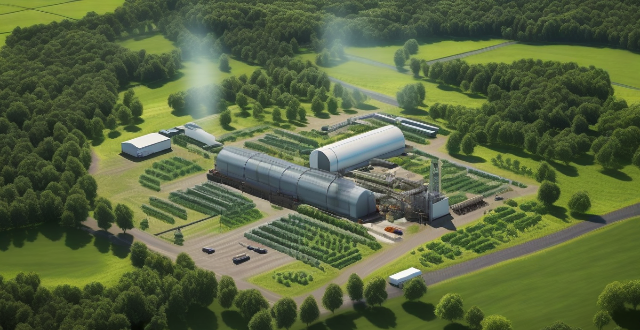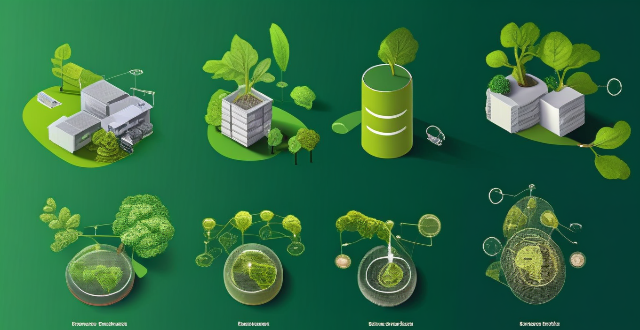Energy Transition

How does energy transition contribute to combating climate change ?
The text discusses the importance of energy transition in combating climate change. It outlines how this transition contributes to reducing carbon emissions, increasing energy efficiency, promoting sustainable practices, stimulating innovation and economic growth, integrating smart grids and energy storage, and enhancing international cooperation. The shift from fossil fuels to renewable energy sources is crucial for mitigating global warming by directly addressing greenhouse gas emissions.

What are the potential health benefits of an energy transition ?
The energy transition from fossil fuels to renewable sources can significantly improve public health by reducing air pollution, mitigating climate change effects, creating economic opportunities in clean energy sectors, and promoting active lifestyles. This shift benefits respiratory and cardiovascular health and can lead to better access to healthcare services. Policies supporting the energy transition should consider both environmental and health objectives for a sustainable and healthier future.

What impact does energy transition have on employment and job creation ?
The energy transition from fossil fuels to renewable sources significantly impacts job creation and employment. This shift brings growth in renewable energy sectors, green economy expansion, research & development, infrastructure development, and energy efficiency services. However, it also causes employment shifts such as a decline in fossil fuel industries, skill transition, geographical impact, supply chain effects, and policy-driven changes. Managing these challenges through strategies like reskilling programs and supportive policies is crucial for a just and equitable energy future.

How does energy transition affect national security and geopolitics ?
Energy transition has significant implications for national security and geopolitics, driven by concerns over climate change, energy security, and economic competitiveness. It promotes diversification of energy sources, enhances energy independence, and addresses cybersecurity risks, strengthening national security. Energy transition can alter power dynamics, mitigate climate change, enhance economic competitiveness, and contribute to environmental security, all of which have significant geopolitical consequences. As the world continues to transition towards renewable energy, it is essential for countries to develop strategies to navigate the complex interplay between energy transition, national security, and geopolitics.

In what ways can technology accelerate energy transition ?
Energy transition is the process of shifting from traditional, non-renewable energy sources to cleaner and more sustainable alternatives. Technology plays a pivotal role in this transition by improving efficiency, reducing costs, and enhancing the performance of renewable energy systems. Key areas where technology can make a difference include renewable energy production, energy storage, smart grids, energy efficiency, and carbon capture and utilization. Innovations in these areas promise a cleaner, more sustainable, and resilient energy future for all.

What is energy transition and why is it important ?
Text: Energy transition is the shift from traditional to renewable energy sources, important for reducing greenhouse gas emissions, promoting sustainable development, and improving energy security. Benefits include economic growth, environmental protection, and social progress.

How will the shift towards electric vehicles impact energy transition goals ?
Electric vehicles play a crucial role in achieving energy transition goals by reducing greenhouse gas emissions, promoting renewable energy sources, and improving energy efficiency. They produce zero tailpipe emissions, leading to improved air quality in urban areas. The increased demand for renewable energy to power EVs drives the development of solar and wind technologies. EVs are more energy-efficient than traditional vehicles and can help reduce energy waste through smart charging systems. However, challenges such as infrastructure development and battery production must be addressed, while opportunities like job creation and technological innovation should be capitalized on to accelerate progress towards a sustainable future.

What role do renewable energies play in the energy transition process ?
The role of renewable energies in the energy transition process is to help decarbonize the power sector, promote sustainability, provide economic benefits, improve energy security, and enhance public health. Renewable sources like solar, wind, hydropower, and geothermal emit little to no greenhouse gases during operation, making them crucial for reducing carbon emissions associated with electricity generation. These sources are also sustainable as they are replenished naturally and do not deplete over time. Investing in renewable energies can lead to job creation, technological innovation, and cost savings in the long run. By diversifying energy sources, countries can reduce their dependence on imported fuels and enhance their energy security. Additionally, renewable energies have lower environmental impacts than fossil fuels, leading to improved air quality and public health benefits.

How can governments promote and support energy transition ?
Governments can promote and support energy transition through policy incentives, research and development, education and awareness, infrastructure development, collaboration with the private sector, and international cooperation.

How does energy efficiency fit into the broader strategy of energy transition ?
Energy transition, the shift to cleaner energy sources, is crucial for mitigating climate change. Energy efficiency plays a key role in this transition by reducing demand and consumption, leading to multiple benefits including reduced emissions, cost savings, and increased energy security. Strategies for integrating energy efficiency include optimizing building design, transportation, industrial processes, promoting renewable energy use, consumer education, implementing supportive policies, and investing in research and development. By prioritizing energy efficiency alongside renewable energy adoption, we can expedite the move towards a sustainable future.

How can cities lead the way in energy transition initiatives ?
Cities can lead energy transition by setting clear goals, implementing regulations, investing in infrastructure, engaging communities, adopting technology, and using financial strategies.

What are the main challenges in achieving a successful energy transition ?
The energy transition to renewable sources faces numerous challenges that encompass technological, economic, policy, social, infrastructure, environmental, geopolitical, and natural limitations. Addressing these obstacles requires a comprehensive approach involving technological innovation, economic incentives, policy support, cultural shifts, international cooperation, and consideration of environmental impacts and resource availability.

How can I transition into a new career field or industry ?
Transitioning into a new career field or industry requires careful planning, research, and a willingness to learn new skills. To make the transition smoother, assess your skills and interests, research potential careers, gain relevant experience through courses, certifications, volunteering, or part-time jobs, update your resume and cover letter, and apply for jobs while preparing for interviews. By following these steps, you'll be well-prepared to make a successful transition into an exciting new chapter of your professional life.

What policies and technologies are needed to transition to a low-carbon energy system that ensures energy security ?
Policies and Technologies for Low-Carbon Energy Transition: To transition to a low-carbon energy system that ensures energy security, a combination of policies and technologies is required. Here are some key elements: Policies: Renewable Energy Targets: Governments should set ambitious targets for renewable energy generation and implement policies to support their achievement. Carbon Pricing: Implementing a carbon pricing mechanism, such as a carbon tax or cap-and-trade system, can help to internalize the external costs of fossil fuel use and make renewable energy more competitive. Energy Efficiency Standards: Setting minimum energy efficiency standards for appliances, buildings, and industrial processes can reduce energy demand and lower greenhouse gas emissions. Research and Development Funding: Investing in research and development for low-carbon technologies can help to drive innovation and bring down the cost of clean energy solutions. Electricity Market Reforms: Reforming electricity markets to better integrate variable renewable energy sources, such as wind and solar power, can improve grid stability and reliability while reducing emissions. Technologies: Renewable Energy Sources: Investing in renewable energy sources, such as solar, wind, hydro, geothermal, and biomass, is essential for decarbonizing the energy system. Energy Storage: Developing energy storage technologies, such as batteries, pumped hydro storage, or compressed air energy storage, can help to balance supply and demand in an increasingly renewable-powered grid. Smart Grids: Deploying smart grid technologies can improve the efficiency and flexibility of electricity systems, enabling better integration of distributed energy resources and demand response capabilities. Nuclear Power: While controversial, nuclear power can provide a low-carbon source of baseload electricity that complements variable renewable sources. Ensuring safety and waste management issues are addressed is crucial. Carbon Capture and Storage (CCS): CCS technology can capture CO2 emissions from fossil fuel power plants and store them underground, reducing overall greenhouse gas emissions from the power sector. Electric Vehicles (EVs): Promoting the adoption of electric vehicles can significantly reduce transportation-related emissions by replacing fossil fuel-powered vehicles with those powered by renewable electricity. Heat Pumps and District Heating: Heat pumps and district heating systems can provide efficient ways to heat buildings using renewable energy sources, reducing reliance on fossil fuels for heating needs.

How is renewable energy affecting the traditional energy market ?
Renewable energy sources are having a significant impact on the traditional energy market, affecting pricing, market share, job creation, and environmental concerns. The increased efficiency and reduced installation costs of renewable technologies have made them more competitive with traditional energy sources, leading to declining electricity prices overall. Additionally, the growing demand for renewable energy sources has led to an increase in their market share, particularly for solar and wind power. The transition to renewable energy is also creating new job opportunities across various sectors of the economy, while addressing environmental concerns associated with fossil fuel consumption.

What are the main sources of sustainable energy ?
The text discusses the various main sources of sustainable energy, including solar energy, wind energy, hydropower, geothermal energy, bioenergy, tidal and wave energy, and hydrogen energy. It also highlights the importance of adopting sustainable energy for environmental impact, economic benefits, energy security, and health considerations. The transition to sustainable energy requires investment, policy support, and technological innovation.

How can individuals contribute to the Clean Energy Revolution ?
The Clean Energy Revolution is a global effort to transition from traditional fossil fuels to renewable energy sources. Individuals can contribute to this cause by adopting renewable energy sources, implementing energy-efficient practices, supporting clean energy policies and initiatives, and raising awareness and educating others. By taking these actions, individuals can play an active role in the Clean Energy Revolution, contributing to a sustainable future for all.

What are the economic impacts of implementing renewable energy policies ?
Renewable energy policies have both positive and negative economic impacts, including job creation, energy cost savings, reduced emissions, higher upfront costs, intermittency issues, and land use concerns. As we transition towards a more sustainable future, it will be important to carefully consider these impacts and work towards finding solutions that balance environmental goals with economic realities.

What challenges does the Clean Energy Revolution face in the future ?
The clean energy revolution is a global effort to transition from fossil fuels to renewable energy sources. This transition faces several challenges in the future, including technical, economic, social, and political factors. Some of these challenges include developing efficient and cost-effective energy storage solutions, upgrading existing grid infrastructure, high upfront costs for renewable energy infrastructure compared to traditional fossil fuel plants, job displacement in industries traditionally reliant on fossil fuels, raising public awareness about the benefits of clean energy, ensuring that clean energy benefits are distributed equitably across different socioeconomic groups and regions, consistent and long-term policy support, coordinated international efforts to tackle global climate change effectively, establishing stringent environmental standards and regulations, and proper planning and allocation of resources for infrastructure projects related to clean energy. Addressing these challenges will require concerted efforts from various stakeholders including governments, industry leaders, researchers, and the general public.

How is climate finance impacting the transition towards a low-carbon economy ?
Climate finance is crucial for the transition to a low-carbon economy, supporting projects that reduce GHG emissions and enhance resilience to climate change. It plays a significant role in various sectors: 1. **Renewable Energy**: Climate finance boosts research, development, and deployment of clean energy technologies, accelerating the shift from fossil fuels. 2. **Sustainable Transportation**: It promotes sustainable transport options like electric vehicles and public transit, reducing carbon emissions from the transport sector. 3. **Carbon Sinks**: Climate finance supports conservation and restoration of ecosystems like forests and oceans, enhancing their capacity to absorb CO2. 4. **Circular Economies**: It drives the transition towards circular economies by funding projects that promote resource efficiency, waste management, and circular business models. While climate finance has made significant impacts, more efforts are needed to meet international climate targets, making continued growth in climate finance essential for achieving a low-carbon world.

How do energy storage systems contribute to sustainable development ?
Energy storage systems are crucial for sustainable development, improving renewable energy efficiency, enhancing grid stability, supporting the shift to electric vehicles, promoting decentralization and local production, mitigating environmental impact, and offering economic benefits. They help balance supply and demand, reduce waste, even out demand spikes, support EV infrastructure, enable microgrids, reduce fossil fuel dependency, increase energy efficiency, save costs, and create jobs. Energy storage systems are a key component in the transition to a low-carbon future.

What are the potential returns on investment for clean energy projects ?
Investing in clean energy projects offers potential financial, environmental, and social returns. Factors such as capital appreciation, dividends, tax credits, carbon emission reductions, air quality improvements, job creation, and energy security contribute to the overall benefits of these investments. As the global transition towards a low-carbon economy progresses, investing in clean energy projects presents a wise and sustainable option for investors seeking both positive impact and financial gains.

What is the role of renewable energy in achieving carbon neutrality ?
Renewable energy is crucial for achieving carbon neutrality, which involves balancing carbon emissions with offsetting actions. By reducing reliance on fossil fuels and greenhouse gas emissions, renewable sources such as wind and solar contribute significantly to this goal. Renewable energy also promotes energy efficiency, economic growth, and energy independence while mitigating climate change impacts. It supports sustainable development goals and fosters innovation and public engagement in environmental issues. The transition to renewable energy offers long-term environmental benefits, making it essential for a sustainable future with stable climates, thriving economies, and healthier societies.

How do renewable energy credits and incentives influence the adoption of green technologies ?
Renewable energy credits (RECs) and incentives are crucial for promoting the adoption of green technologies. They offer economic benefits to individuals, businesses, and governments investing in renewable energy sources, making these technologies more financially attractive. RECs represent proof of electricity generated from renewable sources, while incentives can include tax breaks, grants, rebates, and feed-in tariffs. These mechanisms reduce upfront costs, provide long-term financial benefits, enhance market competitiveness, drive innovation, and foster environmental stewardship. Overall, RECs and incentives are essential for accelerating the transition towards a sustainable energy future.

What impact does climate change legislation have on renewable energy development ?
Climate change legislation significantly influences renewable energy development by providing financial incentives, establishing mandated targets, supporting research and infrastructure, creating consumer awareness, fostering international cooperation, implementing regulations, setting environmental standards, and promoting economic growth through job creation. These measures collectively drive the energy sector towards sustainability and a low-carbon future.

How do clean production technologies impact energy efficiency and conservation ?
Clean production technologies significantly enhance energy efficiency and conservation by reducing waste, optimizing processes, integrating renewable energy, monitoring energy consumption, and promoting product longevity. These strategies not only conserve energy but also align with broader sustainable development goals, offering economic benefits, environmental stewardship, and social responsibility.

What is the role of renewable energy in achieving climate commitments ?
Renewable energy is a key component of global efforts to reduce greenhouse gas emissions and mitigate climate change, contributing to environmental protection, economic prosperity, and social well-being. It reduces carbon footprint, enhances energy security, stimulates economic growth, improves public health, supports sustainable development, advances technology and innovation, and contributes to international cooperation. The transition to renewable energy is crucial for meeting climate commitments and ensuring a sustainable future.

How can institutional investors contribute to the transition to a low-carbon economy ?
Institutional investors play a crucial role in driving the transition towards a low-carbon economy by integrating environmental, social, and governance (ESG) criteria into investment decisions, engaging with companies on sustainability issues, supporting green bonds and other sustainable finance instruments, promoting transparency and accountability, leveraging influence through shareholder power, collaborating with other investors and stakeholders, investing in innovation and startups, and measuring and reporting impact.

Can renewable energy sources effectively replace fossil fuels ?
- Renewable energy sources are sustainable and produce fewer emissions than fossil fuels. - Intermittency, storage, and cost are challenges to the adoption of renewable energy. - Grid integration, energy storage advancements, and government policies can help overcome these challenges.

Why is it difficult to transition away from fossil fuels ?
Transitioning away from fossil fuels is a complex challenge that requires overcoming numerous barriers across economic, political, technological, and social dimensions. It involves not only changing practices within the energy sector but also transforming broader societal attitudes and behaviors related to energy consumption.